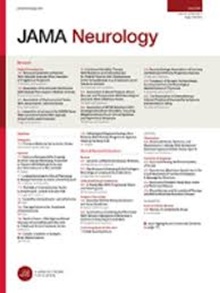Risk of Poststroke Epilepsy Among Young Adults With Ischemic Stroke or Intracerebral Hemorrhage
IF 20.4
1区 医学
Q1 CLINICAL NEUROLOGY
引用次数: 0
Abstract
ImportancePoststroke epilepsy (PSE) is a major complication among young adults and is associated with problems with functional recovery and daily life. Although scores have been developed to predict risk of PSE, they have not been validated among patients with stroke at a young age.ObjectivesTo investigate both the risk of and risk factors for PSE at a young age and validate current PSE risk scores among a cohort of young adults.Design, Setting, and ParticipantsThis cohort study used data from ODYSSEY (Observational Dutch Young Symptomatic Stroke Study), a prospective cohort study conducted among 17 hospitals in the Netherlands between May 27, 2013, and March 3, 2021, with follow-up until February 28, 2024. Participants included 1388 consecutive patients aged 18 to 49 years with neuroimaging-proven ischemic stroke or intracerebral hemorrhage (ICH) and without a history of epilepsy. Statistical analysis took place between June and August 2024.ExposureFirst-ever neuroimaging-proven ischemic stroke or ICH.Main Outcomes and MeasuresPoststroke epilepsy was defined as at least 1 remote symptomatic seizure (>7 days). Cumulative incidence functions were used to calculate the 5-year risk of PSE. Fine-Gray regression models were used to identify risk factors associated with PSE (age, sex, clinical stroke, and neuroimaging variables). The performances of the SeLECT (severity of stroke, large-artery atherosclerosis, early seizure, cortical involvement, and territory of middle cerebral artery) 2.0 risk score (for ischemic stroke) and the CAVE (cortical involvement, age, bleeding volume, and early seizure) risk score (for ICH) were assessed with C statistics and calibration bar plots.ResultsThis study included 1388 patients (ischemic stroke, 1231 [88.7%]; ICH, 157 [11.3%]; median age, 44.1 years [IQR, 38.0-47.4 years]; 736 men [53.0%]; median follow-up, 5.3 years [IQR, 3.4-7.4 years]), of whom 57 (4.1%) developed PSE. The 5-year cumulative risk of PSE was 3.7% (95% CI, 0.2%-4.8%) after ischemic stroke and 7.6% (95% CI, 3.5%-11.8%) after ICH. Factors associated with PSE after ischemic stroke were an acute symptomatic seizure (<7 days) (hazard ratio [HR], 10.83 [95% CI, 2.05-57.07];缺血性中风或脑出血的年轻成人卒中后癫痫的风险
卒中后癫痫(PSE)是年轻人的主要并发症,与功能恢复和日常生活问题有关。虽然已经开发了评分来预测PSE的风险,但它们尚未在年轻中风患者中得到验证。目的调查年轻时PSE的风险和危险因素,并验证一组年轻人的PSE风险评分。设计、环境和参与者本队列研究使用的数据来自ODYSSEY(观察性荷兰青年症状性卒中研究),这是一项前瞻性队列研究,于2013年5月27日至2021年3月3日在荷兰的17家医院进行,随访至2024年2月28日。参与者包括1388名年龄在18至49岁之间的连续患者,这些患者被神经影像学证实为缺血性中风或脑出血(ICH),并且没有癫痫史。统计分析在2024年6月至8月之间进行。首次神经影像学证实的缺血性中风或ICH。卒中癫痫定义为至少1次远端症状性发作(7天)。采用累积发生率函数计算PSE的5年风险。采用细灰色回归模型确定与PSE相关的危险因素(年龄、性别、临床卒中和神经影像学变量)。采用C统计和校正条形图评估SeLECT(脑卒中严重程度、大动脉粥样硬化、早期发作、皮质受损伤、大脑中动脉范围)2.0风险评分(缺血性卒中)和CAVE(皮质受损伤、年龄、出血量、早期发作)风险评分(脑出血)的性能。结果本研究纳入1388例患者(缺血性卒中1231例,占88.7%;Ich, 157 [11.3%];中位年龄44.1岁[IQR, 38.0 ~ 47.4岁];男性736人[53.0%];中位随访5.3年[IQR, 3.4-7.4年]),其中57例(4.1%)发生PSE。缺血性卒中后PSE的5年累积风险为3.7% (95% CI, 0.2%-4.8%),脑出血后为7.6% (95% CI, 3.5%-11.8%)。缺血性卒中后与PSE相关的因素有:急性症状性癫痫发作(7天)(危险比[HR], 10.83 [95% CI, 2.05-57.07];P = 0.005)和皮层受累(HR, 5.35 [95% CI, 1.85-15.49];P = .002)。脑出血后与PSE相关的唯一因素是皮质受累(HR, 8.20 [95% CI, 2.22-30.25];P = .002)。SeLECT 2.0风险评分的C统计量为0.78 (95% CI, 0.71-0.84), CAVE风险评分的C统计量为0.83 (95% CI, 0.76-0.90),两个评分的校准均良好。结论本研究提示青壮年发生PSE的风险相对较低,与PSE相关的因素与现有风险评分中包含的变量相似,因此也可适用于卒中后青壮年。未来的临床试验应探讨高危患者的最佳一级和二级预防措施。
本文章由计算机程序翻译,如有差异,请以英文原文为准。
求助全文
约1分钟内获得全文
求助全文
来源期刊

JAMA neurology
CLINICAL NEUROLOGY-
CiteScore
41.90
自引率
1.70%
发文量
250
期刊介绍:
JAMA Neurology is an international peer-reviewed journal for physicians caring for people with neurologic disorders and those interested in the structure and function of the normal and diseased nervous system. The Archives of Neurology & Psychiatry began publication in 1919 and, in 1959, became 2 separate journals: Archives of Neurology and Archives of General Psychiatry. In 2013, their names changed to JAMA Neurology and JAMA Psychiatry, respectively. JAMA Neurology is a member of the JAMA Network, a consortium of peer-reviewed, general medical and specialty publications.
 求助内容:
求助内容: 应助结果提醒方式:
应助结果提醒方式:


